 Written by Mike DeWilde, OTR/L
Written by Mike DeWilde, OTR/L
While most of us will experience mobility losses as we age into our older years, declining mobility develops sooner and is often more severe in those of us living with obesity. The fear of falling is a real concern, as more than one in three people aged 65 years or older falls every year. Thankfully, there are several effective ways to prevent falls and help bariatric people get around more easily. Recommended by the VHA and other medical experts and organizations, a bariatric walker or bariatric rollator can help get obese people moving again, providing stability, balance, and walking support. Read on to learn how these popular mobility devices can enhance your life in every way.
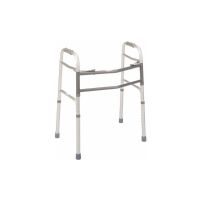 | 700 lbs Days Bariatric Walker View Product |
Perfect for people who need to bear a significant amount of weight on a mobility support device, a standard walker provides the most stability as it does not have wheels. Configured with four legs that are capped with skid-free tips, a standard walker is simple to fold down quickly, with a lightweight design that’s easy to transport. Also known as a basic walker, this type is generally used for older people who are very unstable with a cane, those who do not have the ability to control a rolling walker, and anyone living with bilateral lower-extremity disease. A standard walker must be picked up by the user with every step, placing all four legs of the walker on the ground before stepping forward.
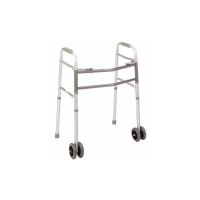 | 700 lb Days Bariatric Two-Wheel Walker View Product |
Delivering more stability than three or four-wheeled walkers, two-wheeled walkers are ideal for people who still need to use the device for weight-bearing and balance, but who don’t need as much support as a standard walker provides. Designed with two back-sliders or rubber-tipped legs and two front wheels, two-wheeled walkers offer safe walking support and more normal walking patterns for users with gait instabilities. Also known as a rolling walker, this style does not have to be lifted with each step and is easier to maneuver over different surfaces than a standard walker. Because the wheels are in a fixed, non-rotational position which results in a wide turning arc, there is a bit of a learning curve involved with making safe turns.
Specially designed with two wheels in the front and one in the back, three-wheeled walkers are considered the fastest, bringing exceptional maneuverability to get into small spaces and get around tight corners. Although they are not as stable as two-wheeled or standard walkers, they’re perfect for people who need some balanced support while moving at a steady pace. Lighter in weight than four-wheeled walkers and generally foldable for convenient portability, three-wheeled walkers offer great walking support for people with low mobility impairment.
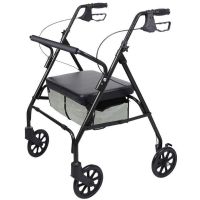 | Bariatric 4-Wheel Walker with Seat by Vive Health View Product |
Less restrictive on normal gait patterns than a standard or two-wheeled walker, a four-wheeled walker is also the easiest mobility aid for most people to propel. Also known as a rollator, this type of walker features four fully-rotating wheels, making it easy to maneuver for turning and navigation in small spaces. Rollator walkers also come with hand brakes to optimize safety and ensure stationary security. Ideal for people of all ages who need a walker for balance but not for complete weight-bearing, four-wheeled walkers also have a fold-down seat for resting when the user tires of walking - a valuable benefit for people living with heart failure, COPD, and obesity. Rollators typically offer a basket or some other kind of storage space to enable users to conveniently carry items hands-free.
.jpg&newwidth=365&maxheight=200) | Walking Tall Deluxe Upright Rollator Walker with Seat and Forearm Support by Platinum Health View Product |
Similar in configuration to a four-wheeled walker rollator, an upright rollator highlights forearm supports and grips that enable users to walk with proper, upright posture. Optimizing balance support, an upright walker provides a more ergonomic option than other walker styles, especially for people who tend to hunch over their walker or rollator. Along with helping to improve posture and reduce back pain, upright rollators also help to mitigate pressure on the user’s hands and wrists, making this a great choice for people living with manual disabilities and conditions. Like other four-wheeled walkers, most upright rollators include seats for resting, hand brakes for safety, and a basket or bag for hands-free storage. Most designs are foldable, but they are bulkier and heavier than standard or two-wheeled walkers.
One of the most important bariatric factors to consider when choosing the best walker to meet user needs is the weight capacity of the device. While standard walkers typically offer weight capacities between 200 to 300 pounds, bariatric walkers usually accommodate anywhere from 300 to 700 pounds. If you weigh over 500 pounds, experts recommend choosing a walker that safely accommodates a higher weight, such as a 700-pound limit or even a 1,000-pound capacity.
For people who tire easily while walking because of obesity and other medical conditions such as COPD and heart disease, it’s important to choose a rollator with a seat. Configured to be out of the way or foldable while walking, a seat provides a quick and convenient place to rest. Be sure to select a model that offers a wide enough seat to ensure safety and comfort. While most standard rollators offer a seat width between 13 to 15 inches, bariatric rollator walkers offer a seat width range that typically falls within 16 to 22 inches (or even wider), ensuring plenty of room for larger adults.
The wheel size is an important determinant, as smaller wheels are generally better suited for indoor use, while larger wheels work better for outdoor use. Because a bariatric walker or bariatric walker rollator has a larger, heavier frame than standard walkers and rollators, they require larger wheels for both indoor and outdoor use. Standard sizes generally range between 2 to 8 inches, while bariatric rollators have 8 or 10-inch wheels. The larger the wheel, the better it will be able to safely navigate over uneven surfaces like cracked pavement, cobblestones, grass, and sand. Smaller wheels optimize maneuverability on indoor flooring and carpeting.
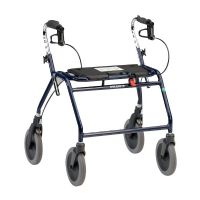 | Bariatric Rolling Walker - Maxi+ by Clarke Healthcare View Product |
Outdoor rollators are specially designed to safely travel over a variety of surfaces, such as sidewalks, city streets, parking lots, and other outdoor expanses. Often including both three-wheel and four-wheel configurations, outdoor rollators look just like their indoor counterparts but will have different tires and a more robust frame. The bigger the wheels, the more terrains the rollator can traverse, including cobblestones, nature trails, sand, and grass. Thicker treads and rugged designs ensure safety and support on uneven, bumpy, or wet surfaces. Because users often take their outdoor rollators along when they travel, this type of walker is conveniently foldable for easy portability in a vehicle. It’s ideal for people who like to get out and about for shopping, visits with friends, recreation, exercise, and any other outdoor excursions.
 | 700 lbs Days Bariatric Walker View Product |
For bariatric people who weigh more than 500 pounds, we recommend a heavy-duty bariatric walker that will accommodate 700 pounds or more. It’s generally best to opt for the next size up to ensure the device will keep safely supporting the user’s fluctuating weight. These larger walkers typically do not have wheels, providing optimal stability and balance support for people living with mobility impairments. They feature a wider space between the handles, reinforced bracing, and adjustable height to ensure strong, comfortable, and durable support for larger bariatric users. The 700+ lbs walkers are also a good option for taller users, as they often accommodate user heights up to almost 7 feet tall.
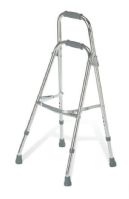 | Adult Hemi One Arm Walker / Sidestepper by Medline View Product |
Perfect for people living with partial paralysis, hemiplegia, post-injury, or other medical conditions that cause weakness on one side of the body, Hemi walkers are used on the side of the body for walking support. Frequently prescribed following a stroke, broken bone, or any other condition that prevents users from using the walker with both hands, this walker type is also often utilized for one-side leg weakness. It has a four-leg base and is held by the user with one hand on the opposite side of their body from the affected side as they walk. Also known as a side walker, side stepper, and one-handed walker, Hemi walkers are ideal for seniors and others, providing more stability and support than quad canes.
Most bariatric walkers and rollators are foldable for quick and easy portability in a vehicle. For users who travel outside their homes regularly, it’s crucial to choose a device that’s light, compact, and easy to take in and out of the car. Bariatric rollators are heavier than their standard counterparts and can range in weight from about 15 to 30 pounds, while bariatric walkers are a bit lighter. It’s important to ensure you or your caregiver will be able to lift the device to and from the vehicle safely.
Possibly the most variable and essential measurement you will need to know, the height of the handle can make all the difference between comfort and discomfort while using a bariatric walker or rollator. Especially important for people who are taller or shorter than average, users should never have an awkwardly high handle grip, nor should they be hunched or bent over the device - both of these situations will cause back pain and strains. The best option is to choose a walker or rollator with handles that are adjustable in height. If the height is fixed, the best way to determine the correct height for the user is to stand up straight with both arms hanging naturally at the sides. Measure from the crease of the wrist to the floor to figure out the best handle height.
If you need to bring along personal items or need a place for purchases, many bariatric walkers and rollators come with a storage basket, bag, or collapsible pouch for easy hands-free carrying. These storage containers provide a convenient, versatile space for small medical equipment as well.
A: Most insurance providers will cover part, or all, of the cost of a walker if it is prescribed by your doctor or a treating provider such as a physical therapist. Check with your insurance provider to learn more about your specific coverage.
A: A bariatric walker typically ranges between 20 to 28 inches in width between the handles and/or casters. Some larger models can provide up to a 32-inch width or more, while some smaller bariatric walkers come with 18-inch width. An adjustable width is available on select models, which makes it easier to get through narrow doorways.
A: A bariatric side walker is used for walking support on the side of the body instead of in the front of the user. Also known as Hemi walkers, one-handed walkers, and side-steppers, bariatric side walkers are ideal for people who only have the use of one hand/arm. Whether it’s due to hemiplegia (partial paralysis), temporary or permanent injury, or amputation, side walkers enable people to just use one hand for operation. They provide a wider base of support, offering more stability than a quad cane, but lighter weight than a regular walker.
A: The weight limit for a bariatric walker is typically around 500 pounds, depending on the walker. Most bariatric walkers accommodate at least 350-pounds, while specialty bariatric walkers can accommodate up to 1,000 pounds.
A: A bariatric walker costs between around $60 to $600, depending on the model. The most basic, standard, non-wheeled walkers are the least expensive, with the more involved four-wheeled walkers and bariatric walker rollators costing the most.
A: The main difference between a bariatric walker and a bariatric rollator is that a walker may or may not have wheels, while a rollator always has wheels. Bariatric walkers without wheels provide the most basic and most stable walking support, which is especially important for users who will need to bear more of their weight on the device. Bariatric rollators have four rotating wheels for faster and more maneuverable walking support, offering balance reinforcement. Bariatric rollators also often come with a seat, brakes, and other safety and comfort accouterments to further enhance the walking experience.
Reduced mobility, overloaded joints, and poor overall fitness can make it difficult for people living with obesity to move about their lives with ease. Bariatric walkers and rollators are recommended by medical experts to help larger people to walk and get around more safely and comfortably, greatly enhancing their lives.
Very common in the U.S., obesity affects almost 42 percent of the adult population. Added to the concerns about the higher risk of heart disease, stroke, and type 2 diabetes, bariatric adults also have a higher risk of falling.
A bariatric walker or bariatric walker rollator is a beneficial independent living aid that provides balance, stability, and walking support for anyone living with obesity. They help people to be more mobile, resulting in improved health and well-being. Specially designed with reinforced bracing, heavy-duty construction, larger wheels, and a more expansive space between the handles, these popular mobility aids come in a wide assortment of styles, sizes, and features to help you find exactly what you need for yourself or your loved one.
Thanks for reading, and we invite you to learn more about the superior quality bariatric walkers and bariatric rollators we carry, along with checking out our comprehensive Obesity & Bariatric Product Catalog. You can also find more informative articles about bariatric support in our Heavy Duty & Bariatric category at Caregiver University.
Mike DeWilde is an occupational therapist in the acute hospital and inpatient rehabilitation settings. He has experience working with a wide range of patients from all walks of life, and he is especially skilled in helping people recover from traumatic and neurological conditions. He’s also trained in the outpatient mental health setting, working with veterans in addiction recovery and holistic health improvement. Mike is motivated in helping drive future improvements to our health care system, such as the development of preventative health programs.